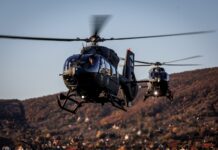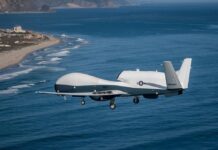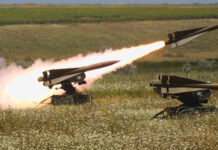From recce to troop transport, medevac to close air support, spec ops, SAR and maritime roles, the versatility of helicopters makes them indispensable work horses on today’s battlefields.
The war in Ukraine is a case in point, where the high-profile use of helicopters by both sides, of often aged, though formidable, Soviet-era airframes flying nap-of-the-earth (NOE) over the battlefields, often in stand-off attack roles, illustrates the many scenarios in which the helicopter plays a core operational role. With Ukrainian forces increasingly tactically dispersed in response to the threat from Russian missiles and long-range precision fires, the helicopter has also been crucial in transporting troops and equipment considerable distances. The war has, however, also revealed helicopter vulnerabilities and their corresponding need to be equipped with latest defensive systems, along with other advanced sensors, if they are to survive the modern battlefield.
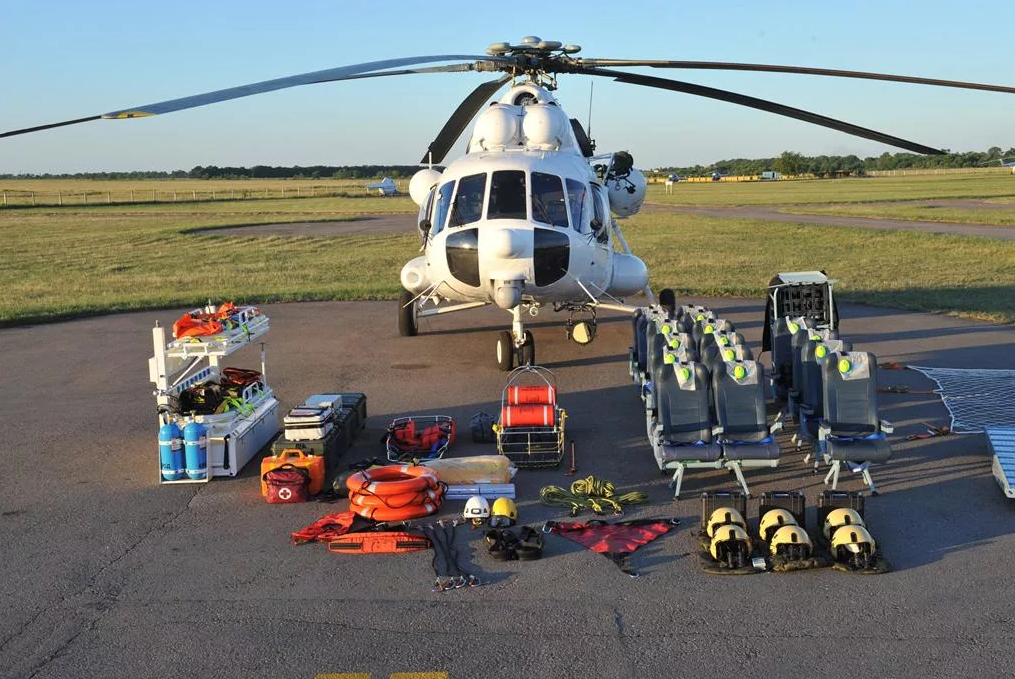
Credit: Ukrainian Helicopters
This article explores the latest rotary-wing developments, some in response to current conflict, with reference to, and comment from, certain leading manufacturers.
Constant innovation, constant demand
With the right upgrades and new avionics, flight controls, smart displays, self-protection systems and more, crucial improvements to rotary-winged flight through a lessening of pilot and crew burden are being achieved by helicopter makers, ensuring manned helicopters will be in constant demand in military operations and critical for decades to come. Exactly what some of those upgrades need to be in the face of changing battlefield tactics, the advent and use of more unmanned aerial vehicles (UAVs), and other operational changes, can be seen in industry developments currently underway.
Airbus Helicopters, for example, which designs and manufactures light and heavy platforms in attack/reconnaissance, utility/transport, as well as maritime categories, integrates most of its helicopters with guided weapons, such as rockets and missiles, and, in some cases, with longer-range, stand-off weapons that can hit targets over 15 km away. The company believes all categories of helicopter are complementary to one another, with military customers needing to have the choice from standard combat helicopters for conventional force operations, to more specialised platforms offering specific capabilities to meet extreme demands such as those of special forces.
According to Patrick Bréthous, military advisor to the CEO of Airbus Helicopters, and himself a former French Army Light Aviation (ALAT) combat helicopter pilot and retired Major General, agility is also key factor for military customers, who want helicopters that can fly low and are agile enough to follow the terrain to avoid being seen, or detected, as much as possible. He said this in the context of the conflict in Ukraine, which has also shown how important self-protection systems are, with increasing military requirements for electronic warfare (EW) systems and flare launchers. In addition, military users in such high-intensity ops need to be able to fly in difficult weather conditions, either by day, or by night, in order to retain an element of surprise, and here there is increasing demand for advanced avionics, sensors and flight controls to enable such operational capabilities. Reducing crew workload to allow them to focus on their mission is also a key factor, one for which advanced onboard mission systems can now help pilots prepare and conduct missions. In addition, reliable and robust onboard connectivity is critical, to ensure any helicopter involved in operations is fully integrated into any, or all, military command and control systems. Crews must have good vision and as full an understanding of the tactical situation around them as possible. In this context, manned-unmanned teaming (MUM-T) – between the manned helicopter and UAV assets – is, according to Bréthous, also increasingly requested by customers as a prerequisite capability for any prospective purchase, and will progressively become a standard feature for military helicopters, one that will not only allow a crew to access data gathered by UAVs, but also enable them to control one, or more, drones in flight, themselves.

Credit: Airbus
MUM-T broad agreement
These MUM-T requirement and other sentiments were echoed by Boeing’s Mark Ballew. He said that with rotorcraft demand remaining strong worldwide, as well as the rise in UAVs, the company was working with its own customers to offer different and more advanced technologies to improve efficiency, and help ensure helicopter crews have the best chance to accomplish missions and survive. He added that the company was exploring autonomy as a capability on all of its enduring and future platforms, leveraging technology that, in part, already exists across the enterprise. He cited as an example the increased importance of MUM-T across all helicopters, in order to give pilots more comprehensive situational awareness (SA) of the whole battlespace. He noted that the AH-64 Apache had been operating with MUM-T capabilities for nearly 10 years, adding that the company’s experience in autonomy and unmanned vehicles, which operate in multi-domain operations over land, sea and in the air, as well as beyond Earth’s atmosphere, included the Boeing Insitu ScanEagle, MQ-25 Stingray, and MQ-28 Ghost Bat, as examples of the kinds of unmanned craft with which helicopters would collaborate. While recognising that autonomy is part of the future of flight, Ballew emphasised that nothing can, as yet, truly replace the eyes and ears of a human pilot, so the future of autonomy, at least in the near term for helicopters, will be a combination of the two.
Leonardo Helicopters, which also recognises a rapid increase in the uptake of UAVs, expects the balance between manned and unmanned military rotorcraft will shift in favour of unmanned in the coming decades. In the meantime, the company has conducted its own trials of MUM-T, (what it calls Crewed-UnCrewed Teaming – CUC-T), over the past four years, including of UAVs integrated with the mission system aboard one of its AW159 helicopters. This allowed the helicopter crew to control the drone from their cockpit, as if it was one of the chopper’s own onboard sensors. In general, while improving overall mission effectiveness, the company sees key benefits of MUM-T in also reducing the risk to aircrew in high-threat scenarios through improving their SA, and thereby allowing pilots to remain central to a mission without increasing their workload.

Credit: Leonardo
A company statement also underpinned the increase in operational range that can be achieved using MUM-T, due to the unmanned asset being able to operate with ‘high persistency’ beyond the horizon of the manned helicopter’s own onboard sensors, while at the same time providing valuable data to the pilots of the crewed aircraft. With that, also comes increased mission efficiency, an overall cost reduction of an operation, with the more expensive crewed asset used only when necessary, and greater reliance placed on the UAV. This combination, in an era where aircrew fatigue is a serious limiting factor, MUM-T ensures that greater overall operational persistence is possible.
Commercial-military confluence
As one might expect, there are a number of influences from the commercial helicopter sector with potentially favourable impact on the military market; platform configurations, as well as onboard technologies are often relevant to both sectors. A civil-sector air ambulance, for example, configured as an emergency medical service platform, might have considerable influence on the final configuration and onboard equipment carried by a casualty evacuation (CASEVAC) chopper on the battlefield. Several other areas of overlap also exist and include aspects such as those of noise and safety. The former sees demand in the civil market for reduced noise levels from aircraft and is well reported, relating particularly to light and medium helicopters operating in urban environments.
By modifying the tail rotor, for example, and enclosing it in a fenestron – first developed in the 1940s – manufacturers can reduce rotor noise levels; typically, instead of the two to four blades of a conventional rotor, a fenestron-encased tail rotor may have 7-18 blades. Numerous aircraft have sported fenestrons over the years, with the Boeing-Sikorsky RAH-66 Comanche stealth helicopter, along with Airbus’ UH-72B variant of its established Lakota; of which the first new variant was delivered to the US Army’s National Guard in September 2021. The benefit of lower noise levels to the military customer, making helicopters more discreet, is, perhaps, more important than ever in the face of today’s enemy forces, which are more likely than not to be equipped with advanced acoustic sensors and listening devices.
On the issue of safety, this is where the civil world drives innovation, with standards often higher than those for purely military aircraft. As a result, military helicopters, especially when derived from civil-certified platforms, often benefit from improved levels of safety.
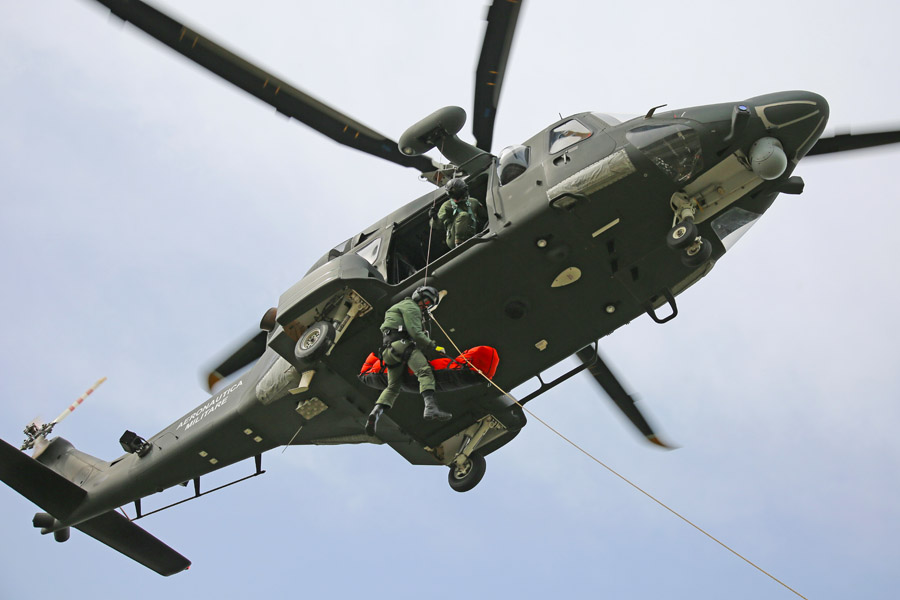
Credit: Leonardo
And while not directly an airframe component, one on-the-ground civil helicopter fleet development, with potential for beneficial operational impact on the military helicopter ecosystem, warrants a mention. This is in the area of maintenance, repair and operations (MRO), where civil helicopter operators, in the quest for faster turnaround times, greater aircraft availability, and less ‘dead time’ on the ground for their aircraft, are turning to the use of interactive 3D technical publications by their MRO teams. These 3D publications provide complex-equipment, product documentation that offers easy-to-use digital troubleshooting tools, connected services and support, all of which gives technicians the information they need in a digital format to be able to maintain aircraft efficiently, to the highest standards, and without compromising safety. It also enables MRO to be conducted quickly. Such an approach will be of direct operational benefit to military customers/users, particularly in conflict, where, with simplified maintenance plans, reduced maintenance workloads and less time on the ground for aircraft, more helicopters will be in the air, more of the time.
A current example of this civil-military confluence is the work between Boeing and Leonardo on the Grey Wolf programme, with the multi-mission, MH-139A Grey Wolf, essentially a militarised version of Leonardo’s AW139 helicopter. The reconfigured aircraft is replacing legacy USAF UH-1N Iroquois helicopters and will protect intercontinental ballistic missile installations, as well as transport security and US Government personnel. The first four Grey Wolf test versions were delivered to the USAF in August 2022.
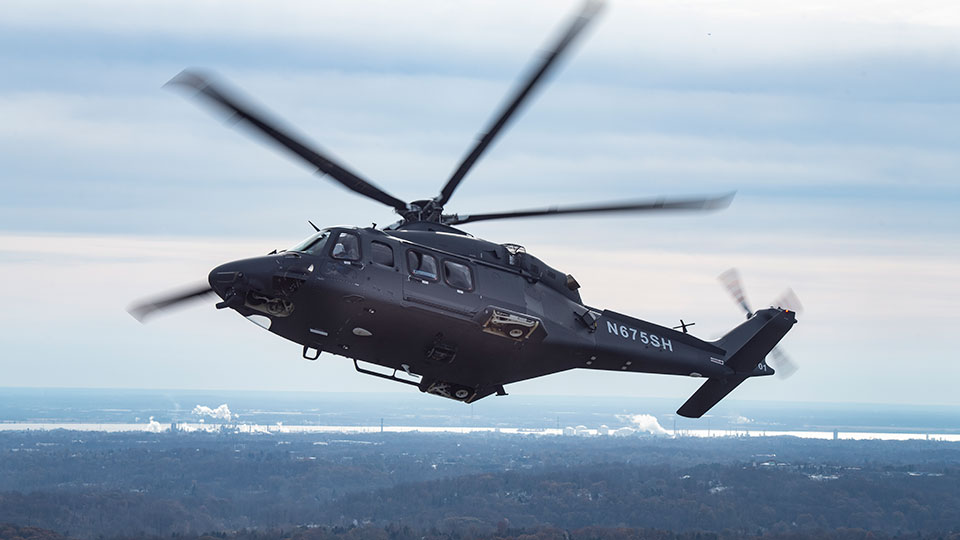
Credit: Boeing
Avionics and onboard tech
Innovations in avionics and onboard flight technologies are many across both the commercial and military helicopter sectors, and tend to focus, particularly in the military domain, on reducing crew workload and increasing SA, as well as improving safety. At the same time, many proven, exceptional military aircraft, such as the Chinook, have had manufacturers working tirelessly to upgrade and extend their lifetimes, and typically include many new onboard innovations.
Of these, Airbus’ Bréthous said that glass cockpits were currently available with new large displays that can be reconfigured to allow the crew to access critical information at the right time. He also said there had been a focus on the human machine interface (HMI), ensuring crew are able to navigate easily within a helicopter’s latest avionics system, with touch screens progressively being introduced and integrated aboard some aircraft alongside new avionics and mission systems, with those same screens either used to display information related to the flight and the aircraft, or tactical information from the battlespace. With connected avionics, a helicopter’s crew can exchange information not only with other aircraft and troops on the ground and command centres, but also, in the context of MUM-T, with unmanned systems.
With two of the biggest challenges – improving SA and reducing crew workload – facing today’s helicopter operations and driving innovations in avionics and cockpit technologies, a system developed in response to these two drivers is Leonardo’s HELIAWARENESS Mission Management System (MMS), which is intended to enhance mission effectiveness by providing crews with a single integrated picture of the operational environment. The MMS fuses data from sensors, such as radar, optronic and automatic identification systems, with relevant information extracted and combined into a common, real-time picture intended to make the crew’s life significantly easier.
Continuous upgrade
When it comes to upgrades and extensions, at Airbus Helicopters, the company applies a continuous improvement policy to its entire range, with new features tested regularly and new sensors and weapons integrated as they become available, a policy, Bréthous said, which also focuses on increasing safety standards and reducing maintenance workload. Bréthous added, “A good example is the H145M; new weapons are being integrated thanks to the open architecture of the HForce weapons system. The Spike ER2 missile is currently being integrated following a customer request and will be available for future operators. The H145M has also been used to experiment MUM-T with various scenarios, and a 17 inch foldable display is under development.” It is understood that the H225M helicopter also benefits from that policy; its maximum take-off weight has been increased by 160 kg and the aircraft is now equipped with what the company claims are the largest cockpit displays on the market, together with a new interface.
For Boeing, upgrades to maintain and extend existing airframes are highlighted by latest developments with Chinook Block II and Apache aircraft. Mark Ballew said that the US Army recently announced they were moving toward full production of the CH-47F Block II programme, a decision which will benefit the global Chinook user community and those interested in acquiring Chinooks for the first time. International operators will see improved affordability, but they will also be maintaining critical interoperability with the US Army when either undergoing modernisation efforts, or purchasing aircraft for the first time.

Credit: Boeing
“The beauty of the Block II programme,” Ballew continued, “is that it provides both a near-term and a long-term solution for our heavy-lift customers.” The Block II configuration provides enhanced capabilities, including a reinforced airframe, an improved drivetrain and redesigned fuel tanks, all of which enable the Chinook to lift more and fly further. Looking long term, Block II provides structural and design improvements that allow customers the ability to easily integrate further enhancements, such as a more powerful engine.
Of Apache, Ballew added that the focus was on modernising the aircraft for the future. “Beyond MUM-T, we’re working on making Apache compatible with the modular open systems architecture (MOSA) ecosystem, improving performance and adding additional flight control assists to reduce operator workload.”
Importance of HMI
Last November, Airbus announced it had successfully tested a new simplified HMI along with advanced autonomous features, through a project code-named Vertex. Bréthous explained the Vertex demonstrator that was tested on their Flightlab, consisted of a fully automated flight, controlled by a pilot via a tactile tablet, during taxi, take-off, cruise, approach, and final landing.
Bréthous said, “The objective of the demo flight was twofold: to carry out a demonstration of a fully-automated flight from take-off to landing, and to increase the maturity of the different techno-bricks. Vertex aims to enhance helicopter safety by increasing SA through automatic obstacle detection and reducing pilot workload through a simplified flight control system, thus enabling helicopter pilots to focus on high-level decisions.” The overall concept of the demonstrator is to let the system take over as much as possible from the pilot to simplify the mission; the aircraft flies along a predefined trajectory, although the pilot remains in control and can take over whenever necessary. Bréthous added, “The system is interesting, as it could improve the safety of low-level helicopter flights when helicopters are close to obstacles such as pylons, power cables, bridges, or terrain. The project took the technology to technology readiness level, TRL, 4.”

Credit: Airbus
It is understood from Boeing’s Ballew, that the company is working on a similarly simplified flight control system for helicopters, moving away from the traditional cyclic/collective/pedal controls. Ballew noted that human factors engineering, and flight interface control development have been a focus, with the company always looking at ways to reduce operator workload and make the vehicles more responsive, easier and safer to fly. “For example, for modernised Apache,” he said, “the flight control system will help with small adjustments to keep the vehicle level and oriented correctly, while the pilot makes larger manoeuvres, manually.”
Operational lessons
With some final comments on how operational trends and lessons from Ukraine might be driving developmental trends, Patrick Bréthous said, “Airbus Helicopters’ military experts keep a close eye on what is going on in Ukraine, but also in other military operations across the world; a lot of lessons learned can be underlined. The first, is obviously the massive arrival of UAVs on the battlefield, which means that combat helicopters must be able to cooperate with this new asset, at least to be coordinated in flight, though the best being to operate with them.”
He added that recent operations had shown that helicopters can be vulnerable when flying in daylight and if they fly too high, he emphasised that high speed can help with agility for NOE flights, as well as the ability to fly by night – all key to a helicopter’s survival over the battlefield. He also stressed that operations in Ukraine have demonstrated that helicopters must be equipped with precise stand-off weapons and advanced self-protection suites, and that in such high-intensity conflict they will likely suffer combat damage; anything that can help repair them quickly and easily makes sense, if a high level of fleet readiness and availability is to be ensured, factors which echo earlier sentiments on the advantages of employing advanced digital 3D MRO procedures from the civil sector, in the field.

Credit: Boeing
Technological advances are pushing and pulling at the fabric of military helicopter development. Whether from sophisticated surface-to-air weaponry and targeting systems, making the skies above Ukraine and other theatres dangerous places for any kind of rotary-winged craft and requiring manufacturers to respond by equipping platforms with effective self-protection systems and avionics, or simply because the competition has a lead on, say, a flight control development. In the latter case, development may, one day, see the cyclic, the collective, and pedals all disappear, to be replaced by a single, control – what is certain is that the manned, military helicopter, configured, or specifically developed for a particular application, is here to stay for the foreseeable future, even with the advent of UAVs. For now, UAVs actually look like being the manned helicopter’s best friend – as long as it’s one of their own.
Tim Guest








